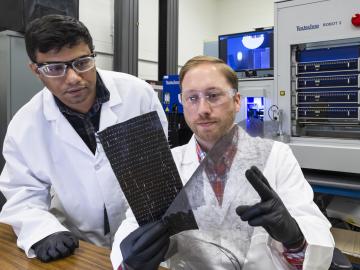
Strengthening the competitiveness of the U.S. transportation industry depends on developing domestic EV batteries that combine rapid charging with long-range performance — two goals that often conflict. Researchers at ORNL have addressed this challenge by redesigning a key battery component, enabling fast, 10-minute charging while improving energy density and reducing reliance on copper.

Researchers at ORNL have developed an innovative new technique using carbon nanofibers to enhance binding in carbon fiber and other fiber-reinforced polymer composites – an advance likely to improve structural materials for automobiles, airplanes and other applications that require lightweight and strong materials.

Recent advancements at ORNL show that 3D-printed metal molds offer a faster, more cost-effective and flexible approach to producing large composite components for mass-produced vehicles than traditional tooling methods.

A research team from the Department of Energy’s Oak Ridge National Laboratory, in collaboration with North Carolina State University, has developed a simulation capable of predicting how tens of thousands of electrons move in materials in real time, or natural time rather than compute time.

Analyzing massive datasets from nuclear physics experiments can take hours or days to process, but researchers are working to radically reduce that time to mere seconds using special software being developed at the Department of Energy’s Lawrence Berkeley and Oak Ridge national laboratories.

As demand for energy-intensive computing grows, researchers at ORNL have developed a new technique that lets scientists see how interfaces move in promising materials for computing and other applications. The method, now available to users at the Center for Nanophase Materials Sciences at ORNL, could help design dramatically more energy-efficient technologies.
ORNL has developed a network of autonomous science laboratories outfitted with state-of-the-art artificial intelligence and robotic systems and connected to the lab’s world-class user facilities. The goal is to supercharge the research process while producing scientific breakthroughs that would be unachievable in a traditional setting.
ORNL, the Tennessee Valley Authority and the Tennessee Department of Economic and Community Development were recognized by the Federal Laboratory Consortium, or FLC, for their efforts to develop Tennessee as a national leader in fusion energy.

Gerald Tuskan, director of the Center for Bioenergy Innovation and a Corporate Fellow at ORNL, has been awarded the Marcus Wallenberg Prize, the world’s highest honor in the field of forestry, for his pioneering work in sequencing and analyzing the first tree genome.
Scientists at ORNL have developed a method that can track chemical changes in molten salt in real time — helping to pave the way for the deployment of molten salt reactors for energy production.

